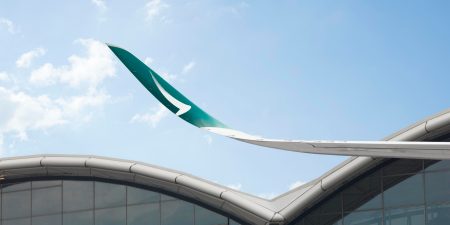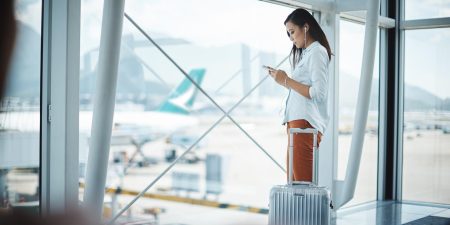
Cathay Pacific releases traffic figures for June 2022
Cathay Pacific carried a total of 150,077 passengers last month, an increase of 269.2% compared to June 2021, but a 95.2% decrease compared to the pre-pandemic level in June 2019. The month’s revenue passenger kilometres (RPKs) increased 320.2% year-on-year, but were down 91.7% versus June 2019. Passenger load factor increased by 45.3 percentage points to 67%, while capacity, measured in available seat kilometres (ASKs), increased by 36.2% year-on-year, but decreased by 89.3% compared with June 2019 levels. In the first six months of 2022, the number of passengers carried increased by 113.5% against a 26.6% decrease in capacity and a 129.8% increase in RPKs, as compared to the same period for 2021.
The airline carried 104,559 tonnes of cargo last month, a decrease of 4.4% compared to June 2021, and a 36.2% decrease compared with the same period in 2019. The month’s cargo revenue tonne kilometres (RFTKs) decreased 14.6% year-on-year, and were down 39.1% compared to June 2019. The cargo load factor decreased by 12.1 percentage points to 68.4%, while capacity, measured in available cargo tonne kilometres (AFTKs), was up by 0.5% year-on-year, but was down by 44.1% versus June 2019. In the first six months of 2022, the tonnage decreased by 4.3% against a 31% drop in capacity and a 35.7% decrease in RFTKs, as compared to the same period for 2021.
Travel
Chief Customer and Commercial Officer Ronald Lam said: “We continued to see positive developments in June following further adjustments to travel restrictions in Hong Kong. As sentiment for travel continued to improve, we resumed more flights to more destinations and deployed additional passenger flight capacity – about 170% more than we did in May – to meet the demand. However, we still only operated about 11% of our pre-pandemic capacity. Load factor increased to 67% and we carried on average more than 5,000 passengers per day.
“The additional flights that we operated helped provide greater connectivity for our transit passengers, notably from the Chinese Mainland. We also saw increased demand for flights between the UK and Australia, as well as between the US and the Philippines. As is typical for June, demand for student travel into Hong Kong was strong and our flights from the UK averaged high load factors of 93%. We also resumed flights to Auckland in June, which saw good demand not only to and from Hong Kong, but also between New Zealand and the UK as well as India. On the other hand, our flights to the Chinese Mainland remained limited by capacity restrictions relating to anti-pandemic measures there.
Cargo
“For cargo, we resumed our full freighter schedule in June with increased flights to the Americas and Europe. This was complemented by the belly capacity provided by our increased passenger flights as well as more than 600 pairs of regional cargo-only passenger flights. In total, we operated about 56% of our pre-pandemic cargo flight capacity last month.
“Tonnage picked up month on month in our home market, Hong Kong, underpinned by more stable cross-border feeder services. Tonnage from the Chinese Mainland also improved as pandemic restrictions eased. Cargo traffic from the Americas and Europe has also been encouraging, with increased frequencies on our long-haul services bringing more cargo to Asia. Overall, tonnage increased by more than 13% month on month, but was below the levels of June last year. This was largely due to reduced consumer demand from North American and European markets, and supply chain disruptions taking time to recover.
Outlook
”Looking ahead, we welcome the Hong Kong SAR Government’s recent decision to suspend the circuit-breaker mechanism effective 7 July, which will help provide customers with far greater certainty and confidence when flying to and transiting via Hong Kong. We are also encouraged that the Government is considering possible adjustments to the number of days inbound travellers will need to spend in designated quarantine hotels after arriving in Hong Kong. We continue to actively add back flight capacity as we work to rebuild our hub and network.
“On the passenger side, we expect travel sentiment will continue to improve over the coming months. Assuming current travel and operating restrictions as at the time of this report remain unchanged, we anticipate we will be able to operate up to about a quarter of our pre-pandemic passenger flight capacity levels by the end of the year. Having said that, the pandemic situation remains highly dynamic and we will need to remain agile with regards to managing our flight capacity.
“In terms of cargo, we are anticipating that demand will pick up as we step out from the traditionally slower summer months and into the usual peak cargo season. Notwithstanding the various operational challenges that will be involved in preparing for this increased demand, we target to be operating about 65% of our pre-pandemic cargo flight capacity by the end of this year.
“We have enjoyed improved cash performance since the further adjustments in the travel restrictions and quarantine requirements came into effect on 1 May. We expect that the anticipated capacity increases will continue to have a positive impact on our monthly operating cash burn, such that we are targeting to be operating cash generative going forward. As the pandemic situation remains uncertain, we continue to maintain our focus on prudent cash management.”
The full June figures and glossary are on the following pages.
CATHAY PACIFICTRAFFIC | JUN2022 | % Changevs JUN 2021 | CumulativeJUN 2022 | % Changevs YTD |
| RPK (000) |
|
|
|
|
| - Chinese Mainland | 33,063 | 107.0% | 137,503 | 128.2% |
| - North East Asia | 11,960 | 136.9% | 27,171 | 3.6% |
| - South East Asia | 46,250 | 196.4% | 102,138 | 11.2% |
| - South Asia, Middle East & Africa | 20,676 | 731.4% | 26,222 | 759.6% |
| - South West Pacific | 131,388 | 685.9% | 244,425 | 259.8% |
| - North America | 387,083 | 244.6% | 679,368 | 89.3% |
| - Europe | 352,700 | 436.2% | 592,819 | 230.4% |
| RPK Total (000) | 983,120 | 320.2% | 1,809,646 | 129.8% |
| Passengers carried | 150,077 | 269.2% | 335,462 | 113.5% |
| Cargo revenue tonne km (000) | 564,955 | -14.6% | 2,122,833 | -35.7% |
| Cargo carried (000kg) | 104,559 | -4.4% | 525,877 | -4.3% |
| Number of flights | 1,638 | 21.2% | 7,610 | 19.6% |
CATHAY PACIFICCAPACITY | JUN2022 | % Changevs JUN 2021 | CumulativeJUN 2022 | % Changevs YTD |
| ASK (000) | ||||
| - Chinese Mainland | 85,520 | 52.8% | 490,487 | 94.9% |
| - North East Asia | 32,878 | -30.7% | 103,377 | -56.2% |
| - South East Asia | 79,405 | 2.1% | 206,570 | -54.0% |
| - South Asia, Middle East & Africa | 47,051 | 236.2% | 67,585 | 234.3% |
| - South West Pacific | 297,982 | 12.7% | 480,535 | -48.6% |
| - North America | 490,540 | 8.8% | 936,405 | -45.3% |
| - Europe | 433,650 | 160.6% | 773,849 | 37.4% |
| ASK Total (000) | 1,467,026 | 36.2% | 3,058,808 | -26.6% |
| Passenger load factor | 67.0% | 45.3%pt | 59.2% | 40.3%pt |
| Available cargo tonne km (000) | 825,470 | 0.5% | 2,801,215 | -31.0% |
| Cargo load factor | 68.4% | -12.1%pt | 75.8% | -5.6%pt |
| ATK (000) | 965,945 | 4.5% | 3,094,076 | -30.5% |
Glossary
Terms:
Available seat kilometres (“ASK”)
Passenger seat capacity, measured in seats available for the carriage of passengers on each sector multiplied by the sector distance.
Available tonne kilometres (“ATK”)
Overall capacity measured in tonnes available for the carriage of passengers, excess baggage, cargo on each sector multiplied by the sector distance.
Available cargo tonne kilometres (“AFTK”)
Cargo capacity measured in tonnes available for the carriage of freight on each sector multiplied by the sector distance.
Revenue passenger kilometres (“RPK”)
Number of passengers carried on each sector multiplied by the sector distance.
Cargo revenue tonne kilometres (“RFTK”)
Amount of cargo, measured in tonnes, carried on each sector multiplied by the sector distance.
Operating cash burn / generation
Operating cash burn / generation includes aircraft loan and lease repayments, fuel hedging settlements, but excludes unsecured loan repayment or refinancing, capital expenditure and related new funding and one-off restructuring costs.
Ratio:
Revenue passenger kilometres/
Cargo revenue tonne kilometres
Passenger/Cargo load factor = ------------------------------------------------------------
Available seat kilometres/
Available cargo tonne kilometres










